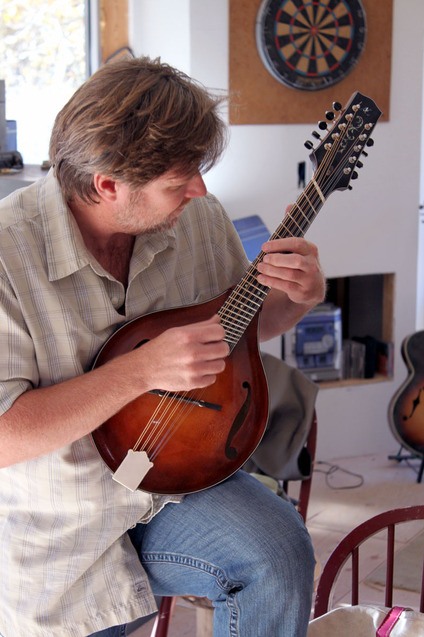« Closing in on Bluesette |
Main
| Vamps. Creating energy with Diatonic triads. »
 August 16, 2012 | Chip Booth on music over time August 16, 2012 | Chip Booth on music over time
We've enjoyed the prose and photography of Idaho musician, Chip Booth. He's recently started up a blog based on his nearly three decades of playing experiences and evolving philosophies. His most recent entry resonated with several articles we've posted based on playing with perfection, performing best in "the zone." With his permission, we've excerpted this below. Hopefully we'll get him to do some guest articles for us, as well.

Chip Booth with a Lawrence Smart 10-string mandolin
"As we begin to learn songs notes are grouped in combinations we refer to as phrases. Musical phrases are much like a written or spoken sentence or sentence fragment: a combination of notes, as opposed to words, whose meaning becomes important in the way they are grouped together. Phrases occur over the course of one more measures. At this point the goal we have in mind is to completete our phrase. The completion of that goal is now a second or more into the future. As you play you may see this goal in sight, and begin to hear your notes not as indiviuals but as a stream of sounds that all lead to a single point, creating a coherent musical thought. This is when our performance has the opportunity to become more nuanced. We can now shape the phrase to add feeling, playing it quietly, or loudly, perhaps crescendoing to a final note. It is the completed phrase that matters most, and individual notes may be given different emphasis with that final goal in mind. Before we play the next note we have imaged the completed phrase, and how each note can best fit into the pattern.
The idea of thinking into the future is probably best illustrated when it comes to improvisation, one of my favourite aspects of playing music. I will talk a lot more about improv techniques, but for now let me limit my thinking to a single concept (that I will talk more about in other articles) which I call "Playing the Right Note at the Right Time". In it's most basic form I will say this is playing a chord tone on the downbeat of the measure. That means playing a note contained with the chord that is currently played by an accompanist on the first beat of a new measure. If the song is on a C chord the improviser can play a C, E, or G note. That downbeat, the first beat of the measure, is going to be the end of our phrase. Rather than starting to play forward from that moment I suggest a more lyrical approach, which is thinking towards that moment. Thinking towards the future. In the measure or measures before this note takes place I will start playing through my scale with the intention of creating a musical phrase that ends on that chord tone on the downbeat. This creates a coherent thought that ends on a note that is in harmony with the music being played. The way we do this is by looking ahead, knowing the future of the music we will play, and making choices now to reflect what is coming."
Read more: Chip Booth blog
Further
Jazz like you speak
Whole(some) notes
Forsaking the notes for the music
Using the picking hand to start Good Tone.
Posted by Ted at August 16, 2012 6:28 AM

Disclaimer: In the 'Information Age' of the 21st Century,
any fool with a computer, a modem, and an idea can
become a self-professed 'expert." This site does not
come equipped with 'discernment.'
|



